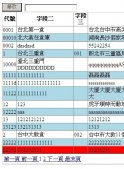1. 文章目的
隨著 WebApiClient 的不斷完善,越來越多開發者選擇WebApiClient替換原生的HttpClient,本文將介紹WebApiClient的接口參數輸入有效性驗證的新特性。
2.DataAnnotations介紹
在 asp.net mvc 服務端編程中,我們在創建模型的時候,使用System.ComponentModel.DataAnnotations相關的驗證特性,配合mvc框架,可以做前端和后端雙向輸入驗證的效果。
|
1
2
3
4
5
6
7
8
9
10
|
public class UserInfo{ [Required] [StringLength(10, MinimumLength = 1)] public string Account { get; set; } [Required] [StringLength(10, MinimumLength = 6)] public string Password { get; set; }} |
以上的Required就是驗證特性, asp.net mvc 在模型綁定的時候,會進行驗證一遍,驗證結果放在控制器的ModelState屬性里面。當然System.ComponentModel.DataAnnotations并不是 asp.net mvc 特有的,而是基礎庫自帶的,也就是說任何框架下都是可以使用的。
3. 接口參數值的輸入驗證
Validator靜態類提ValidateObject相關的方法,用于驗證實例和實例的屬性值,WebApiClient使用Validator類來完成接口方法的參數值輸入驗證:
|
1
2
3
4
5
6
7
8
9
10
11
12
13
14
15
16
17
18
19
20
21
22
23
24
25
26
27
28
29
30
31
32
33
34
35
36
37
38
39
40
41
42
43
44
45
46
47
48
49
50
51
52
53
54
55
|
/// <summary>/// 提供參數值和參數的屬性值輸入合法性驗證/// </summary>static class ParameterValidator{ /// <summary> /// 類型的屬性否需要驗證緩存 /// </summary> private static readonly ConcurrentCache<Type, bool> cache = new ConcurrentCache<Type, bool>(); /// <summary> /// 返回是否需要進行屬性驗證 /// </summary> /// <param name="instance">實例</param> /// <returns></returns> private static bool IsNeedValidateProperty(object instance) { if (instance == null) { return false; } var type = instance.GetType(); if (type == typeof(string) || type.GetTypeInfo().IsValueType == true) { return false; } return cache.GetOrAdd(type, t => t.GetProperties().Any(p => p.CanRead && p.IsDefined(typeof(ValidationAttribute), true))); } /// <summary> /// 驗證參數值輸入合法性 /// 驗證參數的屬性值輸入合法性 /// </summary> /// <param name="parameter">參數描述</param> /// <param name="validateProperty">是否驗證屬性值</param> /// <exception cref="ValidationException"></exception> public static void Validate(ApiParameterDescriptor parameter, bool validateProperty) { var name = parameter.Name; var instance = parameter.Value; foreach (var validation in parameter.ValidationAttributes) { validation.Validate(instance, name); } if (validateProperty == true && IsNeedValidateProperty(instance) == true) { var ctx = new ValidationContext(instance) { MemberName = name }; Validator.ValidateObject(instance, ctx, true); } }} |
4.接口參數的DataAnnotations聲明
4.1 聲明參數值的驗證
例如GetByIdAsync方法有個id的參數,服務器要求必填且最大長度為10的字符串,我們可以使用Required, StringLength(10)特性修飾id這個參數,在接口調用時,WebApiClient會對id值進行驗證,如果不通過則拋出ValidationException的異常。
|
1
2
3
4
5
6
|
// /GET webapi/user/GetById?id=id001// Return HttpResponseMessage[HttpGet("webapi/user/GetById/{id}")][BasicAuth("userName", "password")]ITask<HttpResponseMessage> GetByIdAsync( [Required, StringLength(10)] string id); |
4.2 聲明參數值的屬性驗證
對于自定義的模型類型,只要在屬性里聲明了相關的DataAnnotations,WebApiClient就自動進行屬性的輸入驗證。
|
1
2
3
4
5
6
7
8
9
10
11
12
13
14
15
16
17
|
public class UserInfo{ [Required] [StringLength(10, MinimumLength = 1)] public string Account { get; set; } [Required] [StringLength(10, MinimumLength = 6)] public string Password { get; set; }}// POST webapi/user/UpdateWithJson// Body {"Account":"laojiu","Password":"123456"}// Return json或xml內容[HttpPost("webapi/user/UpdateWithJson")]ITask<UserInfo> UpdateWithJsonAsync( [JsonContent("yyyy-MM-dd HH:mm:ss")] UserInfo user); |
當user參數不為null的情況,就會驗證它的Account和Password兩個屬性。
4.3 聲明參數值、參數的屬性值同時驗證
對于4.2的例子,如果我們希望user參數值也不能為null,可以如下聲明方法:
|
1
2
3
4
5
6
|
// POST webapi/user/UpdateWithJson// Body {"Account":"laojiu","Password":"123456"}// Return json或xml內容[HttpPost("webapi/user/UpdateWithJson")]ITask<UserInfo> UpdateWithJsonAsync( [Required][JsonContent("yyyy-MM-dd HH:mm:ss")] UserInfo user); |
5. 禁用參數的屬性驗證
如果你的模型的屬性已聲明驗證特性,但不希望WebApiClient進行屬性值驗證,可以在創建接口實例的時候,在配置項里禁用屬性驗證:
|
1
2
3
4
5
|
var config = new HttpApiConfig{ UseParameterPropertyValidate = false};var client = HttpApiClient.Create<IUserApi>(config); |
6. 結束語
博主為WebApiClient庫的作者,本文向讀者介紹了DataAnnotations驗證特性在WebApiCiient下的使用方法,歡迎大家給WebApiClient提建議。 也希望大家多多支持服務器之家。
原文鏈接:http://www.cnblogs.com/kewei/p/9406201.html












